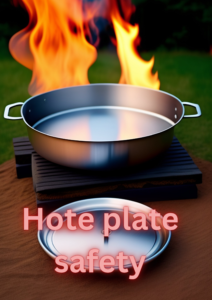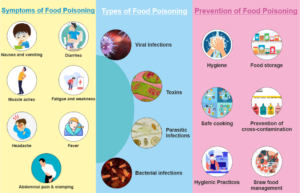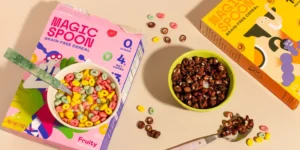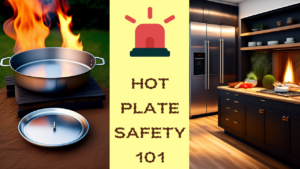“Hot Plate Safety :”

A.Briefly introduce the concept of hot plate Safety and its importance in the kitchen
A hot plate is a portable, electrically powered appliance used to cook or heat food.
It consists of a flat, heat-resistant surface with one or more heating elements underneath.
The hot plate is designed to be placed on a countertop or table,
Providing a convenient cooking surface in situations where there is no conventional stove or oven
available or practical.
Hot plates have many important uses in the kitchen.
First, it serves as a backup cooking option when the main stove is unavailable.
Such as during a power cut or while camping.
This allows you to continue preparing meals and avoid interruptions to your cooking routine.
Additionally, hot plates are commonly used in small kitchens, dorm rooms, or shared living spaces where space is limited.
Because they take up less space than full size stoves.
Hot plates are versatile and can be used for a variety of cooking tasks,
Like boiling, boiling, roasting or roasting. They are often employed to heat beverages,
Sauce, or leftovers. Some hot plates also have multiple temperature settings, so you can adjust the heat according to your cooking needs.
Overall, hot plates offer flexibility and convenience, making them a valuable tool in the kitchen.
Whether you need a temporary cooking solution, need extra burners,
or you are short of space, a hot plate can help you continue cooking and enjoy a hot meal
.
B.Hot plate safety precautions.
When using a hot plate, it is important to prioritize Hote Plate Safety precautions because of the potential hazards associated with heat and electricity. Here are some essential security measures to consider.
- Read the instructions: Familiarize yourself with the manufacturer’s instructions and safety guidelines provided with the hot plate. Follow them carefully to ensure proper use.
- Stable and heat-resistant surface: Place the hot plate on a stable, heat-resistant surface, such as a countertop or table. Avoid using it on surfaces that are flammable or may be damaged by heat.
- Keep flammable materials away: Make sure there are no flammable materials (such as curtains, paper or plastic) near the hot plate, as they may catch fire or melt. Keep a safe distance from any flammable items.
- Unplug when not in use: Always unplug the hot plate when you are finished using the hot plate or leave the area. This prevents accidental activation or overheating.
- Proper ventilation: Make sure there is adequate ventilation around the hot plate. This helps in dissipating the heat and prevents overheating. Avoid using the hot plate in closed spaces without proper air flow.
- Use heat-resistant cookware: Select cookware that is suitable for use on a hot plate and can withstand high temperatures. Avoid using plastic or flimsy materials that may melt or deform.
- Monitor the temperature: Keep a close eye on the temperature setting and adjust it accordingly. Excessive heat can scorch or burn food and can be a fire hazard.
- Avoid overloading circuits: Do not plug multiple high-powered appliances into the same electrical outlet or circuit as the hot plate. Overloading can cause an electrical hazard or trip the circuit breaker.
- Handle with care: Be careful when touching the hot plate or its surfaces during and after use, as they can remain hot for a long time. Use oven mitts or heat-resistant gloves to handle hot cookware.
- Child Safety: Keep the hot plate out of reach of children and educate them about the dangers of touching or playing with the appliance.
By following these safety precautions, you can reduce the risk of accidents, burns, and electrical hazards associated with hot plate use and ensure a safe cooking environment.
II. Understanding Hot Plate Hazards
A. Discuss the potential risks associated with hot plates, such as burns, fires, and electrical hazards
Like any other heating appliance, hot plates have potential risks that users need to be aware of. Here are some of the main risks associated with hot plates:
- Burns: The primary risk when using a hot plate is a burn, which can occur if it comes in contact with a hot surface or hot cookware. Accidentally touching a hot plate or touching hot pots, pans or utensils without proper protection can result in painful burns.
- Fire hazard: Hot plates generate heat, and if not used carefully, they can create a fire hazard. Leaving flammable materials such as paper, plastic or grease near a hot plate increases the risk of fire. Overheating or careless cooking can also ignite food or oil, potentially causing a fire.
- Electrical Hazard: Hot plates operate on electricity, so there is a risk of electrical hazard if not used properly. These hazards include electric shock, short circuit or electrical fire. Overloading an electrical circuit by plugging too many high-power appliances into a single outlet can also cause electrical problems.
- Tipping or instability: Hot plates must be placed on stable surfaces to prevent tipping or instability. If not properly balanced or placed on an uneven surface, hot plates may tip over, potentially causing burns, spills or other accidents.
- Carbon monoxide poisoning (for gas hot plates): Gas-fired hot plates can produce carbon monoxide if they are not properly ventilated or have a malfunction. If inhaled in high concentrations, carbon monoxide is a colorless and odorless gas.
To reduce these risks, it is important to follow the hot plate safety precautions mentioned earlier. Additionally, maintaining good kitchen hygiene, using proper cookware, and practicing proper food handling techniques can further reduce the risks associated with hot plate use. It is also recommended to regularly inspect the hot plate for any signs of damage or malfunction.
It is important to be vigilant and take precautions when using hot plates to minimize potential risks and ensure a safe cooking environment.
III. Hot plate safety and essential precautions
Here are the essential safety precautions to follow while using a hot plate.
1. Read and follow the manufacturer’s instructions and hot plate safety guidelines.
2. Place the hot plate on a stable, heat-resistant surface away from flammable materials.
3. Keep a safe distance from flammable objects and ensure proper ventilation.
4. Always unplug the hot plate when not in use.
5. Use heat-resistant cookware suitable for hot plate safety use.
6. Carefully monitor and adjust the temperature setting.
7. Avoid overloading electrical circuits by using dedicated outlets.
8. Use oven mitts or heat-resistant gloves when handling hot surfaces or cookware.
9. Keep hot plates out of reach of children and educate them about the dangers involved.
10. Inspect the hot plate regularly for any signs of damage or wear.
By using these safety precautions, you can reduce the risk of burns,
fires, electrical hazards, and other accidents when using a hot plate.
V. Hot plate safety & handling techniques
1. Place the hot plate on a stable surface to avoid tipping over or causing an accident.
2. Make sure the hot plate is clean and free of any debris or spills.
3. Use the proper temperature setting for your cooking needs and avoid overheating.
4. Never leave the hot plate unattended while in use.
5. Use the knob or control provided to switch the hot plate on and off.
6. Avoid placing flammable substances or objects near the hot plate.
7. Use heat-resistant and appropriately sized cookware that fits securely on the hot plate.
8. Avoid filling several pots or pans in the hot plate, as this may result in uneven heating.
9. Keep the surrounding area well ventilated to dissipate heat and prevent overheating.
10. After use, here is a brief description of how to deal with common accidents involving hot plates:
V. Responding to accidents and emergencies
A. Here is a brief description of how to deal with common accidents involving hot plates:
1. Burning:
– For minor burns, immediately run the affected area under cool water for several minutes.
Do not apply ice or butter to the burn, as this can make the injury worse.
– If the burn is severe or has covered a large area, seek medical attention.
2. Small Fire:
– If a small fire starts on a hot plate, turn off the heat source and carefully cover the flames with a metal lid or grease or fire extinguisher designed for electrical fires.
– Never use water to extinguish an electrical or grease fire, as this may make the situation worse.
– If the fire is too large to handle or continues to grow, evacuate the area immediately and call emergency services.
Remember, personal safety should always be the top priority when dealing with accidents. If the situation is serious or you are unsure how to handle it, don’t hesitate to seek professional medical or emergency help
.
B. Having a fire extinguisher and first aid kit readily available in the kitchen is extremely important for the following reasons:
1. Fire Extinguisher:
– Fire extinguishers can quickly suppress small fires before they escalate, preventing significant damage or injuries.
It provides a means of dealing with fires caused by oil, grease, electrical equipment, or other kitchen-related hazards.
– Having a fire extinguisher nearby encourages quick response, saving valuable time during emergencies.
2. First Aid Kit:
A well-stocked first aid kit allows immediate treatment of minor injuries and can potentially prevent complications.
– Contains essential supplies such as bandages, antiseptics, gauze and gloves, which facilitate quick care during accidents.
Having a first aid kit available in the kitchen ensures quick access to essential medical supplies when needed.
Overall, keeping a fire extinguisher and first aid kit in the kitchen promotes safety preparedness, allowing for quick action in the event of a fire or injury.
These resources empower individuals to take immediate measures to protect themselves, others and property,
Minimizing potential risks and providing a safe cooking environment.
VI. Maintenance and Care Tips
1. Regular cleaning: Clean the hot plate regularly by wiping it with a damp cloth or sponge. Avoid using abrasive cleaners or scouring pads that could damage the surface.
2. Remove spills promptly: Clean up any spills or food debris immediately to prevent them from sticking or causing damage.
3. Check for damage: Regularly inspect the hot plate for any signs of damage, such as frayed cords, loose connections, or cracks. If you notice any issues,
discontinue use and have the hot plate repaired or replaced.
4. Avoid submerging in water: Hot plates are not designed to be submerged in water. Clean only the surface with a damp cloth and ensure the electrical components remain dry.
5. Store properly: When not in use, store the hot plate in a cool, dry place away from direct sunlight and extreme temperatures.
6. Follow manufacturer’s recommendations: Adhere to any specific maintenance instructions provided by the manufacturer to ensure optimal performance and longevity of the hot plate.
By following these maintenance and care tips, you can keep your hot plate in good condition, prolong its lifespan, and ensure safe and efficient cooking experiences.
VII. conclusion
A. Here are the key safety points covered in the blog post about hot plates:
Read and follow the manufacturer’s instructions and safety guidelines.
Place the hot plate on a stable, heat-resistant surface away from flammable materials.
Keep a safe distance from flammable objects and ensure proper ventilation.
Always unplug the hot plate when not in use.
Use heat-resistant cookware suitable for hot plate use.
Carefully monitor and adjust the temperature setting.
Avoid overloading electrical circuits by using dedicated outlets.
Use oven mitts or heat-resistant gloves when handling hot surfaces or cookware.
Keep hot plates out of reach of children and educate them about the dangers involved.
Inspect the hot plate regularly for any signs of damage or wear.
Following these safety pointers will help reduce the risk of burns, fires, electrical hazards, and other accidents associated with hot plate use, ensuring a safer cooking environment
.
B. It is important to prioritize safety while using hot plates in your kitchen. By following recommended safety guidelines and taking precautions, you can prevent accidents, injuries and property damage. However, safety is a collective effort, and everyone’s experiences and insights can contribute to a safer cooking environment.
Ensure hot plate safety for an enjoyable and worry-free cooking experience.
“We encourage you to make security a priority and share your security tips and experiences in the comments section below. Together, we can foster a culture of safety and promote safe culinary travel for
“Remember, safety should always be the top priority. So let’s come together and share our safety tips and experiences to create a safe cooking environment for all.
Enjoyable and safe cooking!“Ejaz Mansuri

Discover the Magnificent World of Magnesium-Rich Foods
Magnesium-Rich Foods
Magnesium is an essential mineral that plays a crucial role in maintaining our overall health. It is involved in over 300 biochemical reactions in the body,

“The Golden Bachelor” Sizzling at 71: Unveiling the Irresistible Star Gerry Turner.
“The Golden Bachelor” Sizzling at 71: Unveiling the Irresistible Star Gerry Turner. “The Golden Bachelor” is officially here, and he’s proving that it’s never too

Mexico vs. Jamaica: Decisive Showdown and Thrilling Highlights at Concacaf Gold Cup 2023
Mexico vs Jamaica

“Unveiling the Signs of Food Poisoning: Causes, Types, and Prevention”
Welcome to our insightful article, “Unveiling the Signs of Food Poisoning: Unraveling Causes, Varieties, and Effective Prevention Strategies.” In this comprehensive guide, we delve into

Magic Spoon Cereal
Magic Spoon Cereal has revolutionized the cereal industry by offering a guilt-free, low-carb, and high-protein alternative to traditional sugar-laden cereals.

“Hot Plate Safety :”
“Hot Plate Safety :” Hot Plate Safety A.Briefly introduce the concept of hot plate Safety and its importance in the kitchen A hot plate


1 thought on ““Hot Plate Safety :””